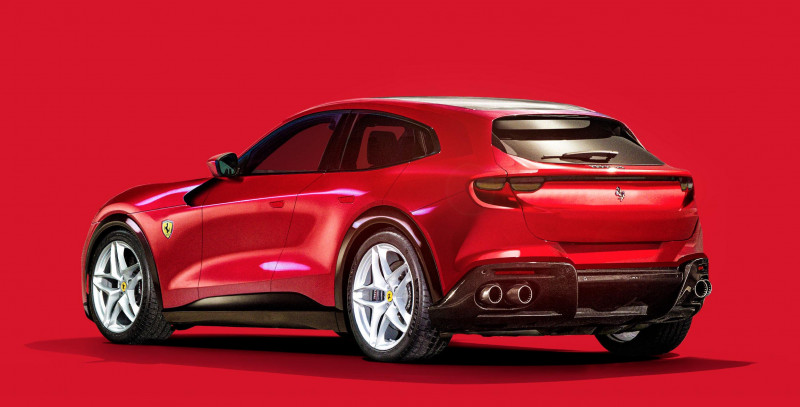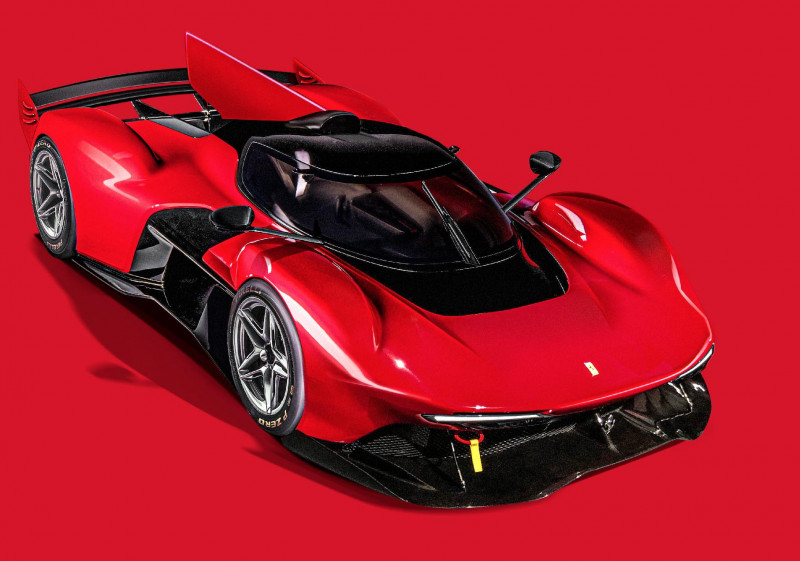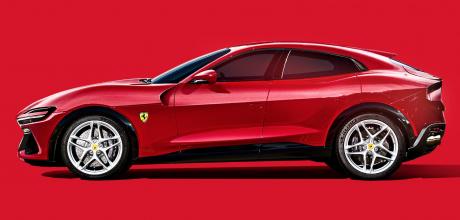Ferrari’s future, starting with its first SUV
Ferrari’s next five years: how the new boss sees the first SUV, the first electric car from Maranello and the new LaFerrari
PUROSANGUE, LEMANS AND THE ELECTRIC FERRARI
Words Ben Miller
Illustrations Avarvarii
Ferrari: the next five years
FERRARI’S SUV WHY V12 PUROSANGUE WILL DRIVE ‘LIKE A SPORTS CAR’ PLUS: NEW SUPERCAR, LE MANS & THE ELECTRIC FERRARI
Synonymous with sports cars and sublime engines, ambitious New Ferrari is ripping up the rulebook with its imminent SUV and 2025 EV.
Mona Lisa-special V12s. Hand-beaten aluminium to move grown men to tears. Scarlet cars scribing black arcs in a symphony of power and control, violence and elegance. Tantrums, world titles and a pair of dark sunglasses. Purple ink. Think you know Ferrari? Think again.

The world is changing, and one of its most valuable and deftly managed car brands is changing with it. There is a restlessness about Maranello right now, and this despite its conspicuous success. Since 2018 Ferrari has generated a cumulated industrial cash flow of more than €2.46bn, expanded its customer base by 25 per cent and launched 15 new models.
What’s more, back in 2018 Ferrari was a combustion-engined car maker – perhaps the definitive combustion-engined car maker. Now it offers the 296 GTB and SF90 hybrids. And come 2025, as part of another 15-car roll-out (2023-2026, as Ferrari targets earnings before interest, taxes, depreciation and amortisation of €2.5bn-€2.7bn and a margin of 38-40 per cent), we’ll see the unthinkable: a Ferrari without an engine.
Is the EV the most important Ferrari since the first Ferrari? New CEO Benedetto Vigna, who started in September, will duly remind you that every Ferrari is special. But you need only look to his appointment for proof that this car matters like few in the storied maker’s 75-year history.
If the Ferrari legend was forged in foundries and machine shops, the coming years will be defined by expertise in electronics and software. The Ferrari difference is fundamental to its value, and it’s to these new battlegrounds that it must translate its superiority. Happily, motor racing, so fundamental to Ferrari’s 20th century success, remains relevant, with Formula 1 and now Maranello’s endurance racing project nurturing in-house EV expertise.

‘We have 120 electronics engineers in F1. They’ve been pushing towards hybridisation for 13 years now,’ notes product development boss Gianmaria Fulgenzi. ‘Electrification and electronics allow us the opportunity to make even more unique cars,’ says chairman John Elkann (who was also caretaker CEO between Louis Camilleri’s departure and Vigna’s arrival). ‘That is why I was convinced that we needed a CEO with a deep understanding of the technologies that are changing not just the automotive industry but also the wider world. Benedetto has the profound technological knowledge required.’
The next few years, as Ferrari spends €4.4bn on product development (of which 75 per cent will go on cars, including a replacement for the V12 812 Superfast, rather than infrastructure), will present Vigna with the opportunity to write himself into Ferrari legend as the electric Enzo.
Before the EV, the SUV
Not long now. Finally, Ferrari has confirmed it will unveil the long-awaited Purosangue ‘SUV’ in September. The company also used its recent capital markets day to announce a couple of technical details.
While some elements of the project, not least its physics-defying suspension, come as no surprise, others are news. For example, the Purosangue will be a niche halo vehicle accounting for less than 20 per cent of shipments, not a Lamborghini Urus or Porsche Cayenne-style volume product. Nor will it offer much by way of driver assistance beyond Level 2. A self-driving Ferrari simply isn’t, bosses claim, the Maranello way.
CEO Vigna: ‘We are not a mobility company. We provide a unique experience. This is key. We will stop at Level 2 plus. We will not go Level 4 or 5. We must always enhance the driving experience, and put the human at the centre of that experience.’ Given Maranello has now confirmed the Purosangue will arrive with Ferrari’s 6.5-litre, turbo-free V12 under the bonnet, being at the centre of this particular driving experience is likely to be quite a privilege…

‘The Purosangue is 100 per cent a Ferrari and it will bring several unique features to the market, including our V12 engine – our most passionate engine,’ says Vigna. ‘We are confident this will meet and exceed all customer expectations for performance, innovation and design. And we will maintain the highest possible level of exclusivity. Purosangue will not be our most relevant product. It will be a very interesting add-on to our product line-up.’
The new CEO has also confirmed he’s driven the car. ‘It is unlike any other,’ he says. ‘I have driven the car in the hills around here and it really is a sports car.’ The Purosangue will use a version of Ferrari’s lightweight and versatile front/ mid-engined platform, which can be configured in various wheelbase lengths and with two- and four-wheel drive, hybridisation or not, and V6, V8 or V12 engines. And while spy footage of the car in dynamic testing suggested a V12 might be in play, confirmation that Ferrari’s most Ferrari engine will power the car is huge news.
Ferrari isn’t yet confirming power outputs or performance figures but the recent 812 Competizione and SP3 Daytona both use an 830bhp evolution of the engine with an unrivalled 9500rpm rev ceiling. Ferrari’s engineers may de-tune the engine a touch for the Purosangue, but don’t count on it… ‘Specific power output is one of our core areas of excellence,’ says Fulgenzi.
‘We are always pushing for more.’ The V12 elevates the Purosangue into a class of one for performance and desirability. The Rolls-Royce Cullinan and Bentley Bentayga both offer 12-cylinder engines but both are very civilised and overtly turbocharged units. Spectacularly, Ferrari’s V12 is neither.
‘The V12 is the most iconic engine in all Ferrari history, targeted to the most passionate members of our family,’ says marketing chief Enrico Galliera. ‘The Purosangue will maintain the highest levels of exclusivity and won’t be our most relevant model from a volume standpoint.’
The four-wheel-drive Purosangue will likely use Ferrari’s twin-clutch transaxle transmission, an e-diff and rear-wheel steering, which has shown on cars like the 812 Competizione that it can deliver breathtaking low-speed agility with rock-solid high-speed stability. Key to giving the Purosangue the agility Ferrari demands will be an innovative new suspension system, FAST – Ferrari Active Suspension Technology.
Back in 2018, then CTO Michael Leiters confirmed such a chassis system was in development, ‘a high-range suspension capable of both comfort and sport.’ Active suspension will give Maranello’s engineers complete control (ride height, pitch, roll, front/rear dynamic weight distribution) over the Purosangue’s body as the car moves, granting them mastery over the difficult physics that come into play when you give a big, relatively heavy and high-riding car an 800bhp V12…
The electric Ferrari
If electrification represents opportunity, it also – perhaps for Ferrari more than any other marque – looks a little like an existential threat. Enzo begrudgingly saw the light on the virtue of putting his engines in the middle of his cars, but a Ferrari with no engine whatsoever?
Well, it’s happening. The LaFerrari was the first Ferrari road car with an electric motor, and come 2025 we’ll see the first Ferrari without a combustion engine. If the notion flies in the face of everything you understand Ferrari to be, it’s also a logical progression from the hybrids that already proliferate in the current range.
Right now, some 20 per cent of Ferrari’s line-up is electrified. By 2026 the new BEV and ongoing hybridisation will shift that mix to five per cent electric, 55 per cent hybrid and 40 per cent combustion engine. By 2030 the electric/hybrid/petrol mix will be 40/40/20.
‘Next for us is the electric powertrain,’ explains Fulgenzi. ‘The electric Ferrari must, first and foremost, be a Ferrari. It must deliver a visceral driving emotion, unique performance and beautiful design.’
So, the BEV will be cut no slack. But Ferrari is further down this road than its EV-less current line-up might suggest. Maranello’s brightest minds have been at work on the e-revolution (and yes, elements of it were televised, mainly on Sunday afternoons) since the dawn of F1’s KERS era.
‘We will derive the latest technology from our racing departments: design, materials and production capabilities,’ confirms Fulgenzi. ‘We will use all our manufacturing and assembling expertise to create unique electric components, optimising specific power to enhance performance and to guarantee driving enjoyment. We will deploy our skills in aerodynamics and mechatronics [integrated mechanical and electronic systems] to increase the range of the car without sacrificing design. And we will integrate our latest vehicle dynamics capabilities to achieve the Ferrari driving emotion and create a unique sound.’
Put it to Fulgenzi that he can’t possibly be serious – that an electric Ferrari doesn’t stand a hope in hell of being as fun to drive as the hyperactive 296 GTB – and his composure refuses to slip. ‘A battery-electric vehicle can enhance some aspects of the driving emotion; aspects that you can’t have with a combustion engine,’ he counters. ‘You lose the gearbox, and you can balance the weight gain by lowering the centre of gravity and reducing the inertia. In this way, when you turn the car you need less force to do so. An EV can be the correct technology for a certain Ferrari.’
To unleash the potential in a performance- orientated, clean-sheet BEV, the 2025 electric Ferrari will use a new platform. Earlier this year Ferrari filed patents showing a two-seater with a low and compact battery unit behind the passenger cell in a ‘mid-engined’ configuration. The battery, which Ferrari will assemble inhouse, mounts rigidly into the structure, bolstering the rigidity of what looks to be an aluminium-intensive structure, but can be removed if required.
‘Battery ageing is a factor,’ acknowledges Fulgenzi. ‘We have to think about the future because a Ferrari must be forever. This is more challenging than developing a combustion engine for life. We have to think about how to change the battery to ensure the same performance.
‘For us also there is a big difference between a fast electric car and a Ferrari with an electric powertrain,’ he continues. ‘At the moment there is no one offering a dynamic experience with an EV – nothing like the enjoyment you get from our hybrid 296 GTB, for example. It’s incredible.
‘With EVs, longitudinal acceleration is easy. But for us is it is important to be fastest around a track, and for this you need everything; dynamics, control integration, weight and aerodynamics.’ Expect the 2025 EV to feature active aero as Fulgenzi’s team balances efficiency with downforce.
CEO Vigna stresses that, for him, electrification simply cannot mark the end of spine-tingling Ferrari powertrains. ‘The emotional side is very important. Electric motors are not silent. Each one of them has its own signature. It is different to the signature of a combustion engine, of course, but it is a signature nonetheless.’
Just as Ferrari designs and builds its engines in-house, so it will create its own electric motors and battery packs in a new purpose-built production facility, the E-building, with the cells sourced from a supplier. Fulgenzi: ‘The powertrains will be designed, hand-crafted and assembled in Maranello. They will be unique. They will be Ferrari motors. When you think about the tolerances of an F1 crankshaft or turbine, these are so small they are difficult to measure and they are difficult to do. We will put this competence into our electric components to reduce weight and dimensions. Cells are a commodity, and by purchasing them we can constantly have access to the best technology available.’
Back to Le Mans
Earlier this year Ferrari confirmed its return to top-flight endurance racing with a hybrid LMH prototype. The car, which has been in development for 18 months and begins track testing imminently, will make its competition debut early next year ahead of an assault on the big prize, Le Mans 2023. Next year’s 24 Hour marks the 100th anniversary of the world’s most important motor race, and Ferrari would dearly love to win it overall again for the first time since 1965.
‘Ferrari is special by definition, and Le Mans is one of the most important races in the world,’ says Antonello Coletta, head of Maranello’s 150-strong (non-F1) motorsport department. ‘We have won the race many times, including nine overall victories and 29 in class. To return to Le Mans was a must, and to do so with a prototype is a dream.’ Like Toyota and Peugeot, Ferrari is building a bespoke LMH car. In doing so it will develop technology for the benefit of its hybrid and battery-electric production cars.
‘When we decided to come back with a prototype racer, we decided to come back with a true Ferrari,’ explains Coletta. ‘For this reason, we chose to come back in LMH. Because to be a true Ferrari we need to make everything; the engine, the aerodynamics, the electrical power, the suspension, the gearbox. We don’t have many parts from the road car in the LMH car. But this is a good laboratory. [Porsche derived a great deal of high-performance EV powertrain knowhow from its 919 Hybrid LMP1 car.] And sure, we have experience of taking a similar path with road cars as we take on the track.’
A new supercar, LaFerrari’s successor Next year Ferrari’s product cycle will gift to the world a successor to the likes of the Enzo and LaFerrari. ‘The highly awaited new supercar will join a long and stunning line-up of models that started many years ago with the 288 GTO,’ confirms Galliera. ‘Four years ago we announced we were starting work on a car in this segment and now we are happy to confirm that it will arrive soon.’
The new machine will lean heavily on technology transfer from Ferrari’s F1 and LMH Le Mans programmes. Documents shown at the capital markets day point to the car being a V8 hybrid, and SF90-based mules have also been spotted testing. But Galliera’s insistence that the new car is a successor to the likes of the Enzo and LaFerrari would suggest that this hotted-up SF90 ‘Speciale’ or ‘Modificato’ is a car distinct from the new supercar.
These landmark supercars, more special even than the Icona machines, have always been conceived around a key new technology. A V12 isn’t likely either; Ferrari has previously pointed out just how heavy such a car would be when the engine is bolstered by hybrid hardware.
Given the V8 SF90 comfortably exceeds the power output of the V12 LaFerrari, either a V8 or V6 hybrid powertrain would provide the required level of performance, and a V6 would mirror Ferrari’s F1 powertrain. While it hasn’t confirmed the cylinder count of its LMH car (which arrives around the same time as the new supercar), Toyota and Peugeot have both gone for a V6. Either way, a level of output-boosting electrification well beyond anything yet seen in a Ferrari would also neatly prepare the world for that EV in 2025…
Current F1 car a shining example of Ferrari’s hybrid competence (when it’s not grinding to a halt…)Our take on what Ferrari’s LMH racer might look like. Might we see a roadgoing twin? Toyota’s done it. Subsequent, possibly non-V12 Purosangue versions will grow Ferrari’s customer base. Our render of the still-secret Purosangue. It will offer V12 power, active suspension and exclusivity
FERRARI WOULD DEARLY LOVE TO WIN LE MANS OVERALL AGAIN FOR THE FIRST TIME SINCE 1965
ACTIVE SUSPENSION WILL GIVE COMPLETE CONTROL OVER THE PUROSANGUE’S BODY
THE PUROSANGUE WILL ARRIVE WITH FERRARI’S 6.5-LITRE TURBO-FREE V12
MARANELLO MEN GIANMARIA FULGENZI Product development boss must create an electric Ferrari, rather than just another EV
ANTONELLO COLETTA Heads up Ferrari motorsport outside of F1. Also runs the XX Programme
BENEDETTO VIGNA Nine months into his new role, the CEO is a physicist and tech entrepreneur
ENRICO GALLIERA The chief marketing and commercial officer is keen to broaden the offering E N G I N E


